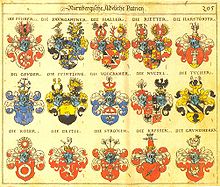Dance statute

The dance statute drawn up in 1521 can be traced back to the politically shaped town hall balls that the Nuremberg magistrate held on certain days of the year, for example on the Sundays of Lord Carnival , or in honor of princes in the old town hall . Almost exclusively members of the families of the Nuremberg patriciate who were able to advise were invited. Advisable meant that the families could send up to two members to the ruling "Inner Council" of the city. (See: History of the city of Nuremberg, The rule of the patricians .)
The dance statute differentiated, in the sense of a closed list, the forty-two patrician families that existed at the time, which were divided according to the age of their membership in the council into twenty old , seven new after 1385 and fifteen other admitted genders who only became admissible after 1440 . However, this distinction no longer played a major role in practice, because a short time later members of the younger sexes were also able to hold the highest offices. In 1521, under certain conditions, six of the more than fifty non-councilors, but “judicially capable” (i.e. judges) so-called “honorable genders”, who formed the second estate , and a few named citizens were admitted to the dance.
The stipulation made in the dance statute expressed the conclusion of a longer development in which the other honorable sexes had been excluded from city authority in the course of the 15th century. As a result, the social mobility of the ruling class largely came to a standstill. In 1536, with the rise of the Schlüsselfelder from Kirchensittenbach to the patriciate , a final amendment to the dance statute followed. No new families could join the council until 1729.
The dance statute, although it had no constitutional or legislative power, shows on the one hand the awareness of the historical development in Nuremberg, on the other hand it demonstrates a political claim to class and social exclusivity, which was defended by all means. The town hall dances are said to have stopped taking place at the beginning of the 17th century. After 1806, with the incorporation of the patriciate into the Bavarian nobility , the dance statute no longer played a formal role, but most of the old families were finally accepted into the baron class .
See also
- Patriciate (Nuremberg) , with table of all patrician genders and "honorable" as well as "judiciary families"
- History of the city of Nuremberg
- Castles, palaces and mansions in the city of Nuremberg
literature
- Eugen Kusch: Nuremberg. City life image. 5th edition. Nürnberger Presse, Nuremberg 1989, ISBN 3-920701-79-8 .
- Christian von Imhoff (Hrsg.): Famous Nuremberg from nine centuries. 2nd supplemented and expanded edition. Hofmann, Nuremberg 1989, ISBN 3-87191-088-0 .
- Andreas Jakob : dance statute . In: Michael Diefenbacher , Rudolf Endres (Hrsg.): Stadtlexikon Nürnberg . 2nd, improved edition. W. Tümmels Verlag, Nuremberg 2000, ISBN 3-921590-69-8 ( online ).

